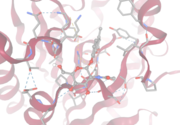Sandbox2QRU
From Proteopedia
Overview
This is a default text for your page Sandbox2QRU. Click above on edit this page to modify. Be careful with the < and > signs. You may include any references to papers as in: the use of JSmol in Proteopedia [1] or to the article describing Jmol [2] to the rescue. The work below details the computational characterization and functional analysis of a protein, 2QRU, with a known crystal structure. Using a variety of computational methods, a variety of key identifiers in the sequences and structure could be isolated to better understand the function of the protein. This is due to the ideology that sequence denotes structure which denotes function. 2QRU is known to be a hydrolase, most active on esterase. The structure is 276 amino acids long, which is approximately 30.14 kDa. Knowing 2QRU is an alpha/beta hydrolase, the literature helped give further information on possible experimental conditions and substrates that can be used to identify activity. However, experimental data has not been obtained yet.
Structure/Sequence AnalysisSequence Analysis SPRITE
Chimera
BLAST Structure Analysis DALI DALI analysis showed certain highly conserved sequences among certain related proteins. Among all the highest related proteins, the 2YH2D showed the closest to the 2QRU active site. The 2QRU sequence has some similarity in short bursts, but nothing long-term. Two recurring sequences were HGGG at around 90 which was present a coil and SAGG around 175 which was present in a helical portion.
SwissDock SwissDock was used to investigate the active site binding of different substrates. The analysis of 2QRU on this site was performed with orientation parameters of 8x20x10 in a 25x25x25 Å box. The best overall interaction tested was with 4-Methylumbelliferyl 2-acetamido-2-deoxy-beta-D-glucopyranoside that showed an affinity -6.883 kcal/mol. Other significant binding affinities include 4-Nitrophenyl acetate at -5.093 kcal/mol and 4-Nitrophenyl acetate at -5.193 kcal/mol. The greatest binding affinities found were with carbohydrate-based substrates.
Proposed FunctionalityBased on the sequence and structural analysis via computational modeling, it is known that the primary function of 2QRU is an alpha/beta hydrolase. Using the Swiss dock, we know the substrates with the highest bonding affinity were sugar-like molecules. This produces bond affinities of -6 or lower. Knowing this, it is hypothesized that 2QRU would be used in biological systems that need to break down sugars for energy, like fermentation or cellular respiration. Where exactly this would occur or on which sugar is unknown at this time, but experimental results may aid in finding what substrate works the best and in what environment.
Relevance | |||||||||||
References
- ↑ doi: https://dx.doi.org/10.2210/pdb2QRU/pdb
- ↑ Herraez A. Biomolecules in the computer: Jmol to the rescue. Biochem Mol Biol Educ. 2006 Jul;34(4):255-61. doi: 10.1002/bmb.2006.494034042644. PMID:21638687 doi:10.1002/bmb.2006.494034042644
https://www.rcsb.org/structure/2QRU


